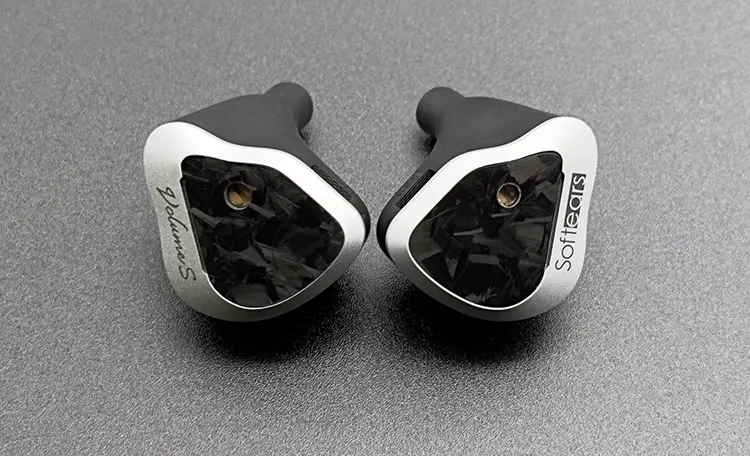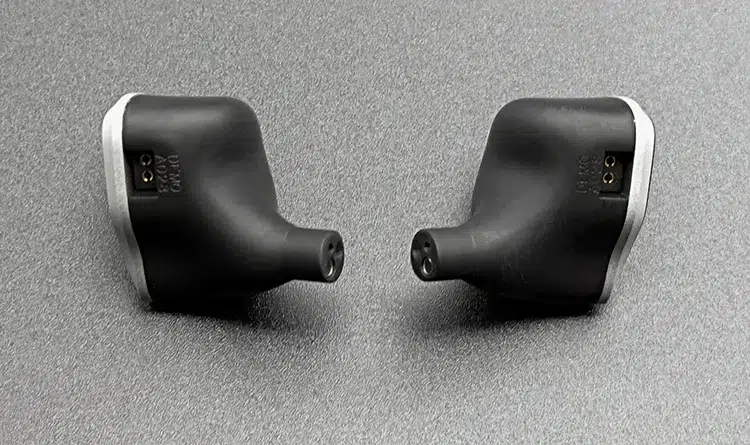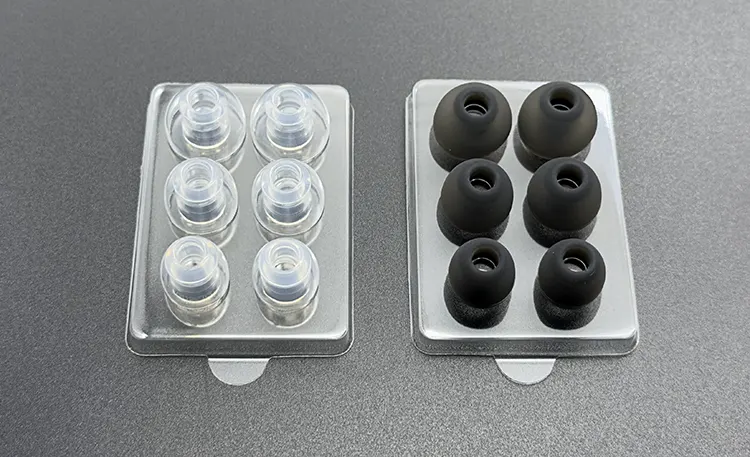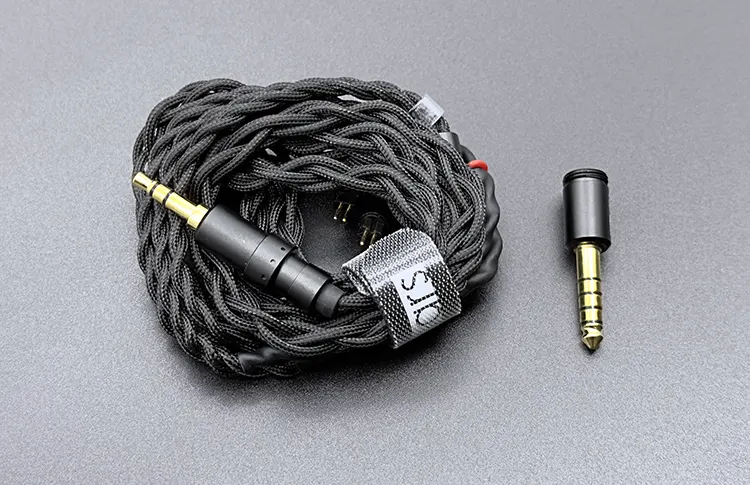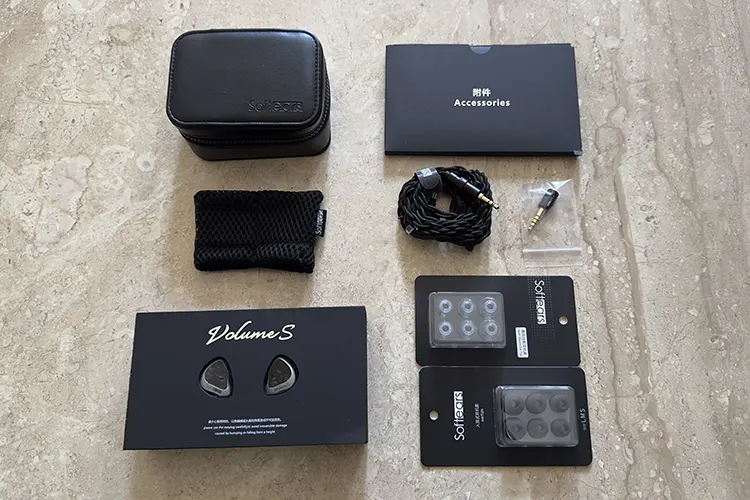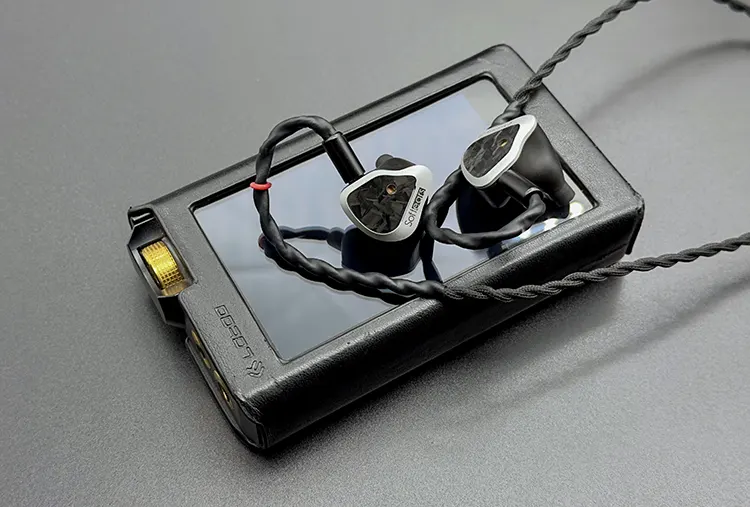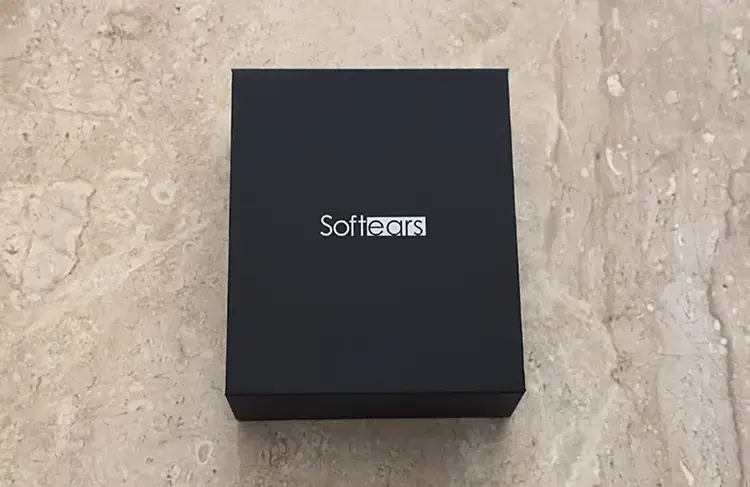In this feature, Nihal reviews the $319 Softears Volume S, a hybrid multi-driver universal in-ear monitor with a new dual tuning mode system.
Disclaimer: This sample was sent to me in exchange for my honest opinion. Headfonics is an independent website with no affiliate links or services. I thank the team at Softears for their support.
Click here to read more about Softears products previously reviewed on Headfonics.
This article follows our latest scoring guidelines, which you can read in more detail here.
A new Softears release is always exciting for enthusiasts. Their IEMs, such as Twilight and Studio 4, have been on the list of favorites for many of us. After releasing the flagship IEM, Enigma, last year, they have released an IEM in the mid-fi category this time.
The $319 Volume S is an upgrade of an older release by Softears from 2022 known simply as Volume.
This update brings a lot of changes, both in terms of appearance and tuning, making it an altogether different IEM. Softears has introduced a new passive radiator along with the dynamic driver and given two tuning modes with the Volume S.
In the $300 category, which is already crowded with decent releases, let us find out if Volume S is just another release or a tough competitor.
In the review, I will compare it with some of the IEMs I like from a similar price range as the Volume S, like the LETSHUEOR Cadenza4, THIEAUDIO Hype 4, and SIMGOT EM10.
Features
The Volume S incorporates a dynamic driver, one acting as a primary driver and a passive radiator assisting in passive mode.
This dynamic driver features a titanium dome and a large silicone suspension design, which helps achieve an impactful and deep low end. The passive radiator features a wool-based diaphragm that absorbs excess vibrations.
Additionally, the IEM features two full-range, self-developed balanced armature drivers. These full-range drivers make the sound more cohesive and tonally balanced.
The Volume S boasts numerous advanced features. It implements a 3-way crossover to manage different frequency ranges effectively. An RC network filters unwanted frequencies to maintain consistent impedance levels.
The IEM also has a low-latency acoustic tube structure that minimizes bends, ensuring smooth and consistent frequency transmission while preserving details. Volume S also uses a physical rear-chamber pressure release structure to relieve ear pressure during prolonged usage.
Design
The Softears Volume S features robustly built medical-grade black resin shells with a soft matte texture. The faceplate is made of an aluminum frame with a forged carbon fiber center.
The center of the faceplate has an abstract design with a unique texture that creates a bright shimmering effect when exposed to light. The design and color scheme follow a minimal approach yet look very artistic.
The IEM connects via a recessed 2-pin 0.78mm socket. The nozzle has a comfortable length and width with a small slit on the faceplate that acts as a vent for pressure release.
The faceplate has a flat tuning switch that you gently adjust by rotating it with the included tool. The ORIVETI OH700VB is another IEM featuring a tuning switch on the faceplates; however, the one on the Volume S sits flush with the surface.
Comfort & Isolation
Most of the Softears IEMs I have tried are quite comfortable, and the Volume S is no exception.
Though the shells are on the larger side, the lightweight and highly ergonomic design makes the IEM very comfortable to use. For Volume S, Softears has collaborated with HEYGEARS to optimize the design by studying ear contour datasets.
The shells have no pressure points or sharp edges that could cause discomfort. The longer nozzle helps achieve a secure insertion, and once in place, they remain very stable. Due to their lightweight design, they are also ideal for on-the-go use.
The isolation is decent, effectively blocking a fair amount of outside noise. Even with a relatively large vent on the faceplate, external noise does not seep in. Pressure buildup is almost negligible, making the Volume S perfect for longer listening sessions.
Ear Tips
Volume S comes with two sets of ear tips, each available in three different sizes: S, M, and L. One set includes the widely praised in-house Ultra Clear (UC) ear tips, while the other consists of B-type balanced ear tips.
The UC ear tips provide a secure fit and are comfortable for extended use. I experience better noise isolation with these ear tips. They have wider bores and are among the most durable ear tips I have used.
The other set, as the name suggests, is designed for balanced sound production. Unlike the UC ear tips, which enhance bass quantity, these ear tips do not boost any particular frequency range.
Both sets of ear tips are well-built and highly usable, eliminating the need to search for third-party alternatives.
Stock Cable
The stock cable on the Volume S features high-purity, oxygen-free copper wire at its core. The cable maintains an all-black look and has a very soft paracord braiding, making it easy to handle.
This four-core wire is lightweight and does not put extra pressure on the ears during use. It is also easy to roll up and doesn’t take up much space due to its comfortable thickness.
The cable features a modular system, allowing you to switch between 4.4mm and 3.5mm plugs depending on your device. I don’t recall Softears ever including a modular cable before. To swap the plugs, you need to unscrew them first, then disconnect and reconnect using a switch-lock system.
The adapter, y-split, and 2-pin connectors are well-built, giving the cable a solid, robust feel. It performs well, so I never felt the need to replace it with another.
Packaging & Accessories
Softears has never disappointed with its packaging, so for those who take unboxing seriously, the Volume S will be highly satisfying.
The IEMs arrive in a medium-sized box that maintains a black color scheme throughout, exuding a sophisticated aesthetic. The box has a sleek black design with a matte finish.
The outer sleeve features the brand’s logo, “Volume S,” and an artistic illustration filled with various musical symbols, including notes, clefs, and other annotations.
Opening the box, we are greeted with two sections: one containing the two IEMs securely placed in a foam cutout and the other holding the carrying case and accessories pack.
The Volume S comes with a generous number of accessories, making the unboxing experience feel almost endless as each item is revealed. The standard accessories include a set of ear tips, a modular cable, and a carrying case.
Additionally, it comes with a cleaning cloth and a thoughtfully included mesh pouch for the IEMs. The quality of the accessories is top-notch, providing a truly premium feel. In this price range, I have not come across any other IEM with a more thoughtful selection of accessories.
Carry Case
The black faux leather case has ample space to store the IEMs along with the cable. It features a zippered closure and is lined with soft fabric on the inside.
The brand’s logo is embossed on the upper flap. The case is soft and supple but sturdy enough to provide protection. Its compact size makes it easy to fit into pockets.
In addition to the carrying case, we also get a mesh pouch to store the IEMs more securely. In my opinion, a mesh pouch is a must for IEMs. Sadly, even some IEMs with metal shells are not included with a mesh pouch, making them prone to scratches.
Sound Impressions
The following sound impressions of the Softears Volume S were completed using a mixture of my main source, Lotoo’s Paw Gold Touch, and occasionally the Questyle CMA18P. For the review, I paired the IEMs with stock cable and Softears UC ear tips, size M.
Summary
The Volume S has two different tuning modes, with the low-impedance mode being the real highlight. We will discuss the high-impedance mode a bit later.
In low-impedance mode, the Volume S features a warm-neutral profile with a nice bass emphasis while maintaining a balanced tuning.
The sound is warm and natural in the midrange frequencies, with detailed but gentle highs. Like many other Softears IEMs, the timbre and tonality hit the sweet spot.
Bass
I am thoroughly impressed by the bass on the Volume S. For me, it has one of the best bass responses among IEMs in its price range. The bass has a nice impact and balance between the sub-bass and mid-bass.
The IEM’s bass is just at the basshead level, so anyone craving deep sub-bass rumbles and a punchy mid-bass should be quite satisfied. This bass does not intrude on the higher frequencies, helping to achieve a clean midrange and treble region.
The bass has a nice speed, and it does not feel too fast or sluggish. You get a dense, full-bodied, and weighty low-frequency response with great texture and layering.
There is also good control in the bass, preventing it from overwhelming bass-heavy tracks. Thanks to the passive radiator, the bass has a good low-end extension with plenty of detail.
In tracks with complex bass, the depth and separation between bass notes are easy to distinguish. Overall, there is nothing much to criticize about the bass response, and for me, it is the best aspect of the tuning, making the IEM fun to listen to.
Midrange
If you have followed Softears IEMs, you know how well they tune their midrange. Be it the Twilight or the Enigma, the midrange has always been spot-on.
Similarly, with the Volume S, the midrange is nicely tuned. You get a touch of warmth with a rich and natural sound. The midrange is just as forward as I prefer, as I like my midrange closer to the ears.
The lower midrange has a good presence with nice depth and body, adding lushness to the sound. Male vocals benefit greatly from the richness of the lower midrange.
Towards the upper midrange, the notes start to thin out a bit. The female vocals could benefit from a fuller body and extended range. Also, due to the way the upper midrange is tuned, I find the Volume S less forgiving of poorly recorded songs, as I encountered a few instances of sibilance.
Other than that, the upper midrange is nicely extended, complementing the lower midrange and enhancing the overall detail and openness of the midrange.
Treble
The treble is not the main focus of the Volume S, but it does not disappoint either, offering the right amount of presence. It provides just enough presence to complete the IEM’s overall tuning without drawing attention to itself.
You get a smooth treble profile with decent extension. The region from the upper midrange to the lower treble remains fairly energetic, exhibiting a good amount of detail.
The upper treble is slightly rolled off and does not feel particularly airy. However, there is still a sense of openness in the sound, and I do not find myself missing the finer details.
The treble remains smooth, free of harshness or sharpness, and is generally non-fatiguing. Treble enthusiasts may find this tuning less appealing, as the expected energy and sparkle are somewhat subdued. Personally, I find the treble response very comfortable.
Staging & Dynamics
The Volume S is not a technical powerhouse but maintains a decent performance on the technical front.
The soundstage has a reasonable width and depth, though it lacks impressive vertical height. While the stage offers a somewhat holographic feel, it does not extend very far or wide.
Instrument separation is decent, providing ample breathing space in complex tracks. The vocals and instruments do not overlap, and they are nicely separated, even in complex passages.
However, the imaging capability is just average, with some lack of precision in instrument positioning. Stereo panning and left-to-right movement are not highly accurate and could be improved.
Additionally, Volume S is not exceptional at resolving finer details, as some microdetails tend to be missing.
High-Impedance Mode
I still can’t quite understand the inclusion of a different tuning mode, as the low-impedance mode is far more impressive.
The high-impedance mode features a tamed bass profile with a stronger focus on the upper frequencies, making the tuning lean toward a brighter sound. The upper midrange to treble region lacks body and has a thin presentation, sometimes exhibiting harshness.
The bass feels lean, missing the impact and punch that make the other mode enjoyable. The midrange is more incisive but lacks warmth.
Honestly, I didn’t spend much time with the high-impedance mode. Adding this mode feels unnecessary, and I can’t help but wonder if a single tuning mode would have made the product more cost-effective.
Click on page 2 below for my recommended pairings and selected comparisons.



